The Dell XPS 13 (9300) Review: Return of the King
by Brett Howse on July 16, 2020 10:00 AM ESTDisplay Analysis
Dell’s move back to 16:10 on their XPS laptop display panels is likely a welcome change for almost all prospective buyers. The PC industry aggressively moved to 16:9 with the rise of HD televisions, and while the 16:9 aspect ratio is still the default for most PC gaming and media consumption, most productivity tasks will enjoy the slightly taller display. Going to 16:10 instead of 3:2 like we have seen on Microsoft’s Surface lineup is also a nice compromise between productivity and consumption.
Dell is offering both 1920x1200 and 3840x2400 display offerings, which is in-line with what they’ve been doing with the XPS 13 lineup since at least 2015. For 2020 though, there is an optional touch digitizer on the lower resolution display, whereas in the past Dell only included touch with the higher-resolution panel. Both displays offer Dolby Vision processing and Eyesafe technology to reduce blue light transmission.
The 1920x1200 panel is a standard sRGB display, rated at 500 nits of brightness. Meanwhile the 3840x2400 panel has a much wider color gamut – offering 90% of the P3 color space – and is HDR 400 certified as well.
Dell sampled us the lower-resolution panel for review, but as with any Windows-based notebook with wider than sRGB gamut coverage, it is still a 'buyer beware' situation. Windows 10 does not offer the best color management system, and since almost all content and programs are designed around sRGB, if you opt for the wider-gamut display colors will be blown out unless you are using an application that specifically supports color management. For most people, the sRGB panel is the better option, not only because the 1920x1200 13.4-inch display still provides a reasonable 170 pixels-per-inch and much better battery life, but also because Windows still deals with wide-gamut and HDR poorly.
One area where Dell needs to be commended though is in their use of anti-glare coatings on their XPS displays. This has been one area that no PC manufacturer has really put much effort in, but Dell offers a 0.65% reflectivity rating on their coating, and it makes a big difference in day-to-day usage, especially in a bright room or outdoors.
To see how the XPS 13 display performs, it was tested using the Portrait Displays CalMAN software suite, using a custom workflow. Brightness and contrast were measured with the X-Rite i1Display Pro colorimeter, and color accuracy measurements were done with the X-Rite i1Pro2 spectrophotometer.
Brightness and Contrast
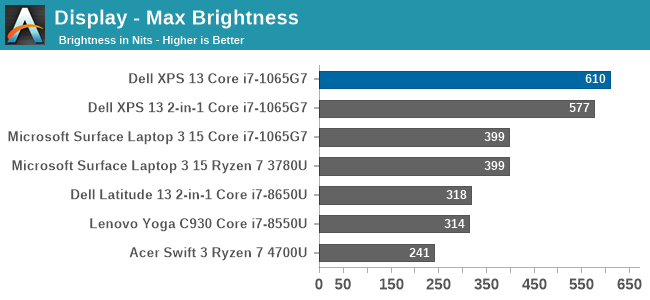
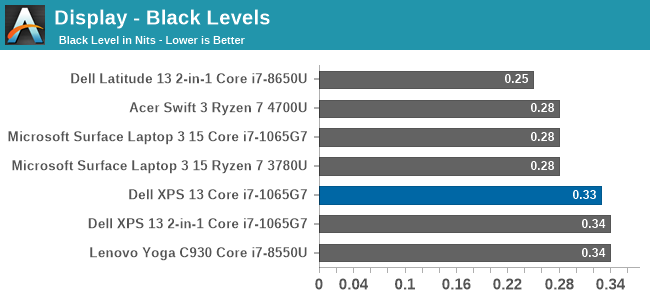
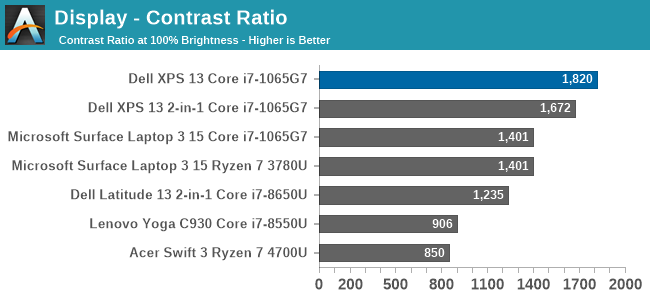
Despite the 500-nit rating, the XPS 13 managed to achieve a very impressive 610 nits of brightness. Coupled with the excellent anti-reflective coatings, the XPS 13 is easily one of the best notebooks for any bright location. The contrast ration of over 1800:1 was also top-notch.
Grayscale
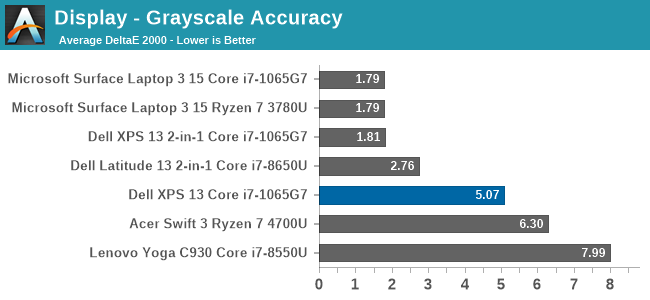
Despite the XPS 13 including an ICC profile, the review unit offered very poor grayscale performance, which was a disappointment after the XPS 13 2-in-1 we reviewed in November had such great results. Dell is likely using a batch-calibration process, rather than tuning each panel individually, which is a shame.
Gamut
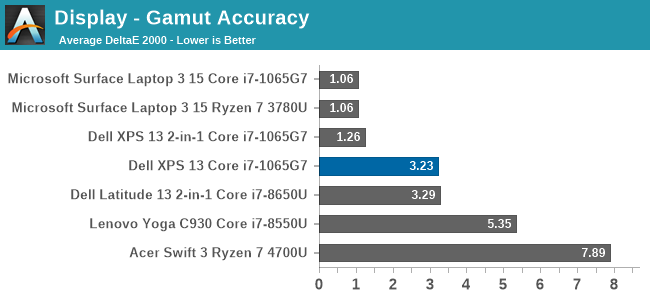
Grayscale aside, the color gamut results show a much better outcome, with really only Cyan having much in the way of color error. The display nicely hits sRGB primary and secondary color points, although does pull a bit to the green end, especially on Cyan.
Saturation
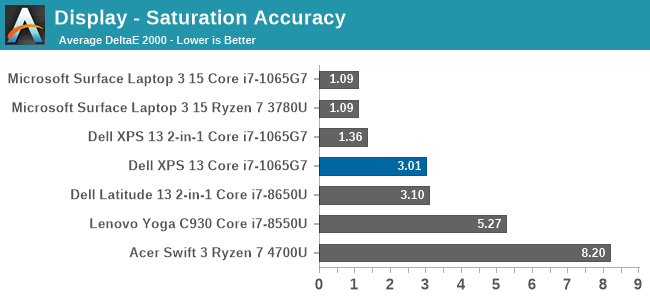
Gamut tests the sRGB color space at the 100% levels, but for the saturation test each primary and secondary color is tested in 4-bit steps from 0% to 100%. Really, other than the Cyan errors, the XPS 13’s color accuracy on these sweeps is quite good, just missing the 3.0 DeltaE threshold.
Gretag Macbeth

The Gretag Macbeth colorchecker tests many colors, not just the primary and secondary colors, and includes the important skin tones. To be considered accurate, all of the color tests on the DeltaE 2000 scale should be under the yellow line, and for the most part that is the case. The grayscales and the most impacted, which isn’t surprising with how inaccurate the grayscale was on this unit, with only a few colors over the 3.0 error level.
Colorchecker
The colorcheck swatch provides a relative look at how the display performs. The colors on the bottom half of the swatch are the targeted colors, and the top half is what the XPS 13 was able to provide. This is a relative result, because any error in your own display would impact this swatch.
For the most part, the color accuracy of the XPS 13 is very good, with mostly only grayscale errors. The bad news is that Dell did include an ICC profile to address this, but it had little to no impact on the grayscale. Meanwhile the good news is that since most of the errors are grayscale, if you owned your own calibration tools, the XPS 13 could be adjusted to give a reasonable result. But as a premium device, it would be nice to see Dell extend the calibration to every panel.
















224 Comments
View All Comments
edved - Saturday, July 18, 2020 - link
I rec'd this Dell i7 with 16GB yesterday on the 16th and saw this review! Excellent write-up. Thanks for putting in the time & effort. Certainly reassures my purchase. It replaced a 5 yr old XPS 13.Pixelpusher6 - Sunday, July 19, 2020 - link
I've currently started looking for a new laptop. I'm leaning towards the Ryzen mobiles. One thing I've noticed though is the disappointing RAM options. For my use I need a minimum of 16GB. Using Win10 at work I'm averaging around 12-15GBs of usage, at home it is usually less around 7-10GB unless gaming. I don't understand why OEMs feel the need to solder RAM - do SODIMM slots really take up more space? The laptop I'm replacing is an older laptop that has a 24GB cache ssd soldered on which is failing, (in addition to a 512GB 860evo) and as a result Windows install hangs up, so I can only run Ubuntu. I love this laptop but I need to run Windows. What if you have soldered RAM and it fails outside of warranty?ajp_anton - Sunday, July 19, 2020 - link
I've had this laptop for 5 months and actually have lots of problems with it that Dell just refuses to fix. Their answer to all of the following is that it's "by design".- Custom charging. If you set the charging to stop at, say, 80% or 90% (to prolong the life of the battery), reach the desired level (so that it stops charging), and then stress the CPU, the charging will continuously start and stop at a 1-5 second interval. Because of this, the charging light at the front of the laptop will keep turning on and off, which is very annoying in a dark room.
- Every time the battery starts charging, the screen's backlight will flicker for one second, like there's some instability with switching from battery power to AC. This combined with the issue above makes the custom charging level pretty useless.
- When Panel Self Refresh is turn on (in Intel's settings), the screen will randomly insert black frames once or every 10mins to 10 hours. It's very random. Solution is to just turn off PSR.
- The fans will run when nothing in the laptop is above 60 degrees C. Once they turn on, they will keep spinning for a while even if everything cools down to under 50 degrees C. My experience with the laptop is that the fans just keep running almost all the time when just browsing the web. My cooling setting is set to "quiet".
- Mayor problems with sleep mode. The laptop occasionally wakes up and just loads up the CPU and overheats everything to 100 degrees C when inside my backpack. I've had to hack Windows to re-enable S3 sleep (instead of modern sleep). Since Dell can't handle "Modern standby" correctly, they could at least have a BIOS option to disable to altogether (in fact they have an option to disable S3), so the user wouldn't have to hack-enable it with Windows.
- Home and End button placement is horrible. I've asked to enable Fn+left and Fn+right in a BIOS update, as they used to be in older XPS laptops, and the technician thought it was a good idea, but there's nothing he could do because people higher-up didn't want this.
ajp_anton - Sunday, July 19, 2020 - link
Though in spite of all of these problems, I still like this laptop, and I don't know of a better one. The 16:10 screen alone makes this an obvious choice, and I just have to learn to live with (and work around) all the other issues.nfriedly - Sunday, July 19, 2020 - link
I love the idea controlling charging in software to extend the longevity of the battery!I'm not sure how you could feasibly report this, but I'd like to know how much difference it makes after a few years of use. Does Dell make any claims?
ajp_anton - Sunday, July 19, 2020 - link
There are problems with this particular laptop's custom charging. Read my comment above yours, the first two points.I've used this feature in an older XPS laptop (max charge at 80% except for long flights and such), the Skylake version, which is ~4 years old. It's been in pretty much constant use on-the-go, and battery wear is at 1%.
vermaden - Monday, July 20, 2020 - link
Just get Chuwi Aerobook 13 instead.Bigger and better keyboard (along with more keys) and also TWO USB A 3.x ports and USB C port.
... and it costs about $450 new.
This Dell XPS 13 looks lame to say the least with these only two USB-C ports ...
ajp_anton - Monday, July 20, 2020 - link
Um, what?A Skylake-Y CPU with max turbo at 2.2GHz? That's your alternative to a 4-core Ice Lake? And possibly the slowest iGPU in existence, compared to one of the fastest. 1920x1080 screen. The speakers are "bad, even by laptop standards". And despite the extremely slow and low-power CPU, battery life is also bad.
Yeah, totally comparable.
velanapontinha - Monday, July 20, 2020 - link
If only this was bases on a Ryzen 4700u...Smell This - Monday, July 20, 2020 - link
Well ... Duh!
;- )
Down With The King, Dell